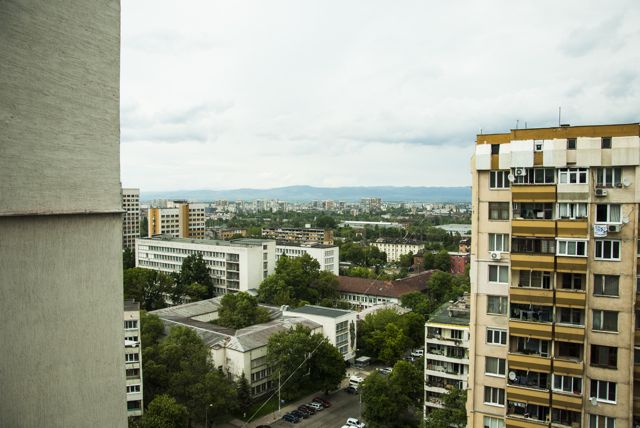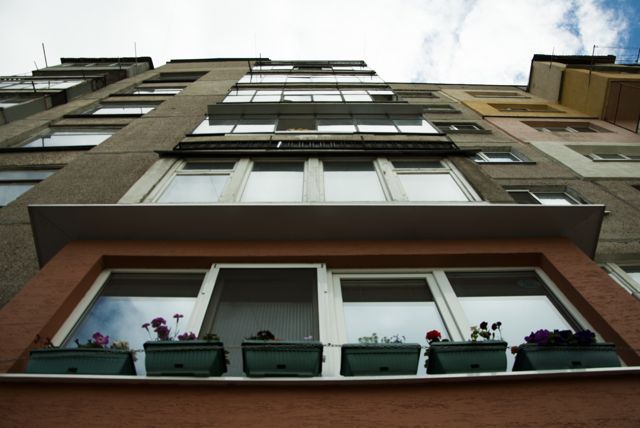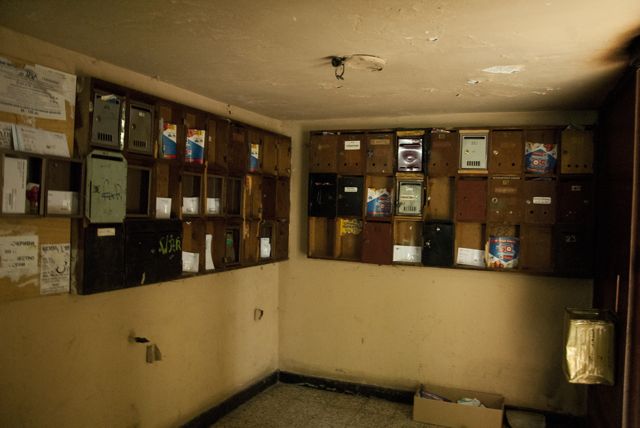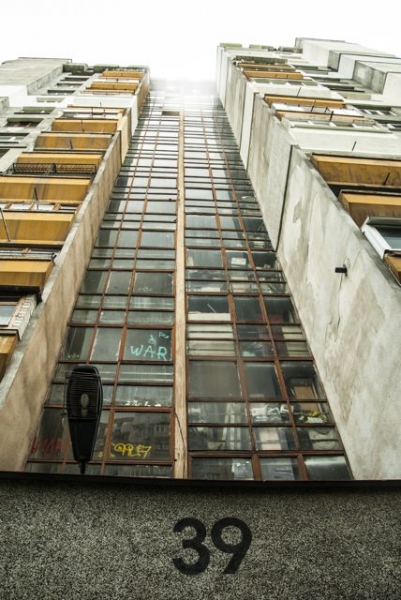Pictures - the author
Polina Spartyanova
The global housing industry puts end buyers in the most disadvantageous position. The whole cycle involving entrepreneurs, banks, building contractors, brokers, and buyers, has been designed so that modern people need to work all their life in order to repay their housing loans. GRReporter sought the opinion of architect Delcho Delchev who after a four-year practice, just before the onset of the Crisis, set up a partnership called ‘Transformatori’ (meaning ‘transformers’) with colleagues who shared his beliefs to counteract the lack of professional, civil, and investment interest in public spaces. Mr. Delchev is the author of a dissertation thesis on the ‘Models for Development of Concrete Panel Housing Complexes’ at the Institute for Art Studies, in which he assesses from a modern perspective the problems and the potential of housing complexes with concrete panel buildings and develops some positive and negative scenarios for their further development.
What is typical of the construction of housing complexes in Bulgaria during the socialist period?
During the socialist period, housing construction went through different stages following the political, economic, and social interests of the day. There were projects of different scales, some of which proved to be successful and still have their benefits nowadays, while others were unsuccessful and seem to be on the edge of utopian ideas of architects and city planners. It is interesting to see the assessment which the contemporary housing market gives them, too. Some complexes in the capital city, for example, ‘Iztok’ and some parts of ‘Lozenets’, have not lost any of their value. On the contrary, ‘old brick’ constructions are appreciated better than ‘new construction’. This is not the case with housing complexes like ‘Lyulin’, ‘Nadezhda’, or ‘Obelya’ where constructions were predominantly built from concrete panels. Obviously, it is not the construction system that matters in this case, but their scale and proximity to the centre of the city, as well as transport and public services, and above all, the social atmosphere in these neighbourhoods. The most crucial and complex problems seem to be those of housing complexes which were built as a result of the reckless expansion of urban areas upon agricultural fields. In addition to being in conflict with modern urban ethics, similar investment ‘decisions’ can regularly be seen even in modern towns and cities which continue to expand horizontally instead of becoming more compact. As a result, a lot of new housing complexes remain with underdeveloped infrastructure, as did some housing complexes which were built earlier.

In conclusion, I would point out a major mistake from Bulgaria’s socialist period – ill-scale industrialisation which triggered hectic construction activity in urban peripheral zones and people’s migration from small towns and villages to major towns and the capital city. Bulgaria went through several housing crises, the mortgage crisis being an example, too, yet they were usually the consequence of natural disasters or military conflicts, rather than planned political or economic activities.
Why did concrete panel construction spread so rapidly over the territory of the country with 30 per cent of Bulgarian population living in those concrete blocks of flats?
A short list of some advantages of concrete panel construction will probably give the answer to the question, or do so at least partially. Despite the prevailing negative attitude, we should bear in mind that construction with prefabricated elements is increasing and unlike other countries, the housing sector and the construction of high-rise buildings in Bulgaria do not make use of its advantages.
Prefabricated construction elements were manufactured in plants in a controlled environment, rather than on the construction site. Housing construction plants used to be similar to 3D printers of concrete elements. The evolution of 3D printing and the crisis in the construction sector have shifted the focus of attention on cutting-edge construction technologies. In addition, there is the time factor – buildings were constructed rapidly, under the pressure of short deadlines typical of planned economy. If the construction of a new block of flats begins near your home, tens or hundreds of families will live as if on a construction site with all its dust and noise for at least a year or two. In contrast, prefabricated elements construction will reduce the period of inconvenience to two or three months only!

In line with the large-scale initiative to satisfy housing demand, reforms were also introduced in the regulations governing housing construction, both in terms of city-planning and architecture. New requirements were introduced regarding space comfort and access to services (public, healthcare, social and transport). Schools, kindergartens, hospitals and supermarkets were to be built in all housing complexes, yet not all of them were built in fact. Many of the new residents of concrete panel complexes went through a culture shock. People who had previously used outside toilets and water heated in the sun, had all in one place conveniences such as central heating and functionally zoned rooms (for the day and night time). A negative culture shock was experienced by those citizens who were accommodated in concrete panel complexes in peripheral areas after living in the centre of towns and cities. In other words, the majority of the population considered it a privilege, and even some progress, to live in the concrete panel complexes. Here is how two words – ‘panelka’ (a derogative term for a small flat in a concrete panel block) and ‘Lada’ (the brand of car which was most common in Bulgaria in that period) became lifestyle benchmarks in urban folklore.
How do concrete panel blocks of apartments fit into the new urban environment in Bulgaria?
The contemporary urban housing environment in most cases is inferior to the environment in concrete panel housing complexes according to a number of indicators. Since neither city-planning policies, nor municipal practices encourage the free construction of homes, market incentives ‘project’ contract construction which was typical of the Middle Ages and is a huge step backwards in urban development. Therefore I see a lot of potential in the construction of concrete panel complexes because of their major resource – free space. A lot of future architects and designers will put their efforts into making the buildings and the environment in those complexes more aesthetic, therefore I believe we will see a lot of interesting projects.
What would be the right approach to private owners of flats in these blocks who equip their homes with glazing and colourful insulation without any consideration for the overall design and appearance of the building? The issue of ownership of concrete panel homes is especially important within its local context. Unlike Germany, France, and other European countries, where concrete panel blocks are public housing and therefore are property of the municipality or the state, municipal housing is an exception in Bulgaria. There are two interpretations for comparing local and global cases.
The positive interpretation of the ownership issue is that of the advantages of homes which have their owners. We see both the positive and negative effects of this in contemporary concrete panel housing complexes. The social microclimate in a concrete panel block of flats in Bulgaria is better than that in a social housing complex in Germany, which is dwelled in by persons with similar social and cultural status, basically unemployed people, immigrants, as well as people with anti-social behaviour. In our case, a highly-paid IT specialist might live next-door to a retired person who finds it hard to survive. Similar blending of different social and cultural layers of society might also lead to conflicts, yet it seems to be closer to natural processes and the opportunity for controlling each other’s behaviour. On the other hand, diverse private interests and opportunities pose significant challenges to the maintenance of buildings and common areas. When a building is owned by the municipality, it would not be a problem to have it evacuated and complexly reconstructed or renovated. In some cases and under certain market conditions, certain concrete panel constructions might even be demolished in line with the housing policy of a municipality. It is a different case though, when multiple private interests are involved. The role of the state is equally important in this scenario, and it relates primarily to providing adequate regulation, encouraging the maintenance of the building through energy efficiency measures, but also to designing models for degradative scenarios, including emergency reinforcement or the resettlement of all residents when they cannot deal with related problems on their own. To put it in another way, the excessive responsibility assumed by government and municipality institutions results in the conversion of social housing complexes into ghettoes, and prevents the development of natural social and evolutionary processes within them.

What is the ‘life expectancy’ of a concrete panel block of flats and how can it be prolonged?
Concrete panel blocks of flats are constructed from reinforced steel elements and the durability of the overall construction depends on the quality and durability of input materials. The same applies to any building with a reinforced steel skeleton frame. The joints between the panels are most vulnerable elements. With most systems they can easily be checked and reinforced if necessary, but in order to prolong the life of a concrete panel building it is essential to protect it from humidity, for example, moisture from the atmosphere, leaks from the water-supply pipes. Even an ill-considered replacement of old wooden window and door frames with new tightly fitting ones might have an adverse effect, if renovation activities are not conducted simultaneously. Another factor which shortens the ‘life’ of concrete panel constructions relates to the unlawful reconstruction and conversion of the building construction. Passportisation of buildings may identify similar problems, yet much of this unauthorized repair activity will remain hidden until some major earthquake hits and causes easily visible damage as a result of the spoilt construction.
There are concrete panel blocks of flats in Sofia, which were built more than fifty years ago and cause much trouble to their residents. In your opinion, what should be the approach to resolving a problem which is expected to become increasingly relevant in Bulgaria?
The focus should be not on concrete panel constructions, but on the maintenance of buildings in general. Bulgarians must be aware that all buildings need to be maintained, whatever materials they were built from, therefore resources must regularly be allocated to that purpose. Perhaps in many of these ‘dangerous’ blocks of flats, there is no good neighbourhood spirit, no active supervision on joint parts, and probably no funds are put aside for capital repairs. In such circumstances, any building will become dangerous not only to its residents.
Do you know how that problem is dealt with in the other countries of the former Eastern bloc?
I will give you an example with the town of Pirna in east Germany, where several sections of a concrete panel block of flats were demolished in order to regulate the market of public rental housing. The land has been rehabilitated and converted into a park. This is a good model for having fewer buildings in a concrete panel complex. Another solution is to remove several blocks of flats or to reduce the number of floors in the remaining blocks. As a result, housing units become smaller which gives a different quality to residing in them.
How do you see the future of concrete panel housing complexes in Bulgaria?
It would be impossible to discuss the future of concrete panel buildings outside the context of neighbourhoods and towns. I would recommend the following trends and principles in order to improve the quality of residence in concrete panel housing complexes:
Further develop their infrastructure and landscape architecture. Even the boring design of a concrete panel block will look better if it is part of some good-looking environment with maintained roads, sidewalks, parks, etc. Many of the concrete panel buildings have been surrounded by mud and pools ever since they were first built.
Improve the cultural infrastructure of concrete panel housing complexes. Quality of residence does not refer to the place of residence only. It is also influenced by the presence or absence of a number of different parameters. It is of crucial importance that each separate neighbourhood or complex has its parks, sports facilities, schools, community culture centres, and entertainment clubs. This would dramatically change their current appearance of ‘town bedrooms’.
Easy access and road infrastructure are major requirements, too. Good transport connections between concrete panel complexes and the rest of a town or city will have a significant positive impact on the quality of residence there.
And last but not least, one of the best opportunities to make the most of the biggest potential of these neighbourhoods, space, is to develop urban agriculture. There are plenty of examples in Europe and around the world that a large part of abandoned or overgrown meadows can be converted into beautiful gardens with just a little effort on behalf of municipalities and citizens.

Which is the better alternative for Bulgarian citizens – concrete panel buildings or new construction, and why?
My personal opinion is based on the advantages and disadvantages of both types of construction. I believe that the construction industry as a whole, i.e. property developers, banks, building contractors, brokers, buyers involved, is to a great extent distorted and unethical. It is absurd that contemporary people need to work all their life in order to pay for their homes. On the other hand, many of the newly constructed residential properties are not worth the money charged for them, since they are ill-considered, nonfunctional constructions almost on the edge of relevant legislation, where corridors are so narrow that paramedics would find it hard to go through them with a stretcher, insufficient car parks, and overbuilt spaces. Therefore, unless I have the necessary funds to buy some high quality new construction property, I would prefer a concrete panel home, again in line with my belief that we should not be slaves to mortgages or loans throughout our whole lives.